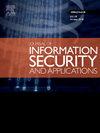Public data-enhanced multi-stage differentially private graph neural networks
IF 3.8
2区 计算机科学
Q2 COMPUTER SCIENCE, INFORMATION SYSTEMS
Journal of Information Security and Applications
Pub Date : 2025-02-09
DOI:10.1016/j.jisa.2025.103985
引用次数: 0
Abstract
Existing differential privacy algorithms for graph neural networks (GNNs) typically rely on adding noise to private graph data to prevent the leakage of sensitive information. While the addition of noise often leads to significant performance degradation, the incorporation of additional public graph data can effectively mitigate these effects, thereby improving the privacy-utility trade-off in differentially private GNNs. To enhance the trade-off, we propose a method that utilizes public graph data in multi-stage training algorithms. First, to increase the ability to extract useful information from graph data, we introduce a public graph and apply an unsupervised pretraining algorithm, which is then integrated into the private model training through parameter transfer. Second, we utilize multi-stage GNNs to transform the neighborhood aggregation into a preprocessing step to prevent privacy budget accumulation from occurring in the embedding layer, hence enhancing model performance under the same privacy constraints. This method is applicable to both node differential privacy and edge differential privacy in GNNs. Third, for edge differential privacy, we introduce an aggregation perturbation mechanism, which trains an edge prediction model on a basis of node features using the public graph data. We apply this trained model to the private graph data to predict potential neighbors for each node. We then calculate an additional aggregation result based on these predicted neighbors and combine with the aggregation result derived from the true edges, ensuring that the aggregation perturbation result retains valuable information even under very low privacy budgets. Our results show that incorporating public graph data can enhance the accuracy of differentially private GNNs by approximately 5% under the same privacy settings.
公共数据增强的多阶段差分私有图神经网络
现有的图神经网络差分隐私算法通常依赖于在私有图数据中添加噪声来防止敏感信息的泄露。虽然噪声的加入通常会导致显著的性能下降,但合并额外的公共图数据可以有效地缓解这些影响,从而改善差分私有gnn中的隐私-效用权衡。为了增强这种权衡,我们提出了一种在多阶段训练算法中利用公共图数据的方法。首先,为了提高从图数据中提取有用信息的能力,我们引入了一个公共图,并应用了一种无监督预训练算法,然后通过参数转移将其集成到私有模型训练中。其次,我们利用多阶段gnn将邻域聚合转化为预处理步骤,防止嵌入层发生隐私预算积累,从而在相同隐私约束下提高模型性能。该方法既适用于gnn中的节点差分隐私,也适用于边缘差分隐私。第三,针对边缘差分隐私,引入聚合摄动机制,利用公共图数据基于节点特征训练边缘预测模型。我们将这个训练好的模型应用于私有图数据,以预测每个节点的潜在邻居。然后,我们根据这些预测的邻居计算一个额外的聚合结果,并结合从真边得到的聚合结果,确保聚合扰动结果即使在非常低的隐私预算下也能保留有价值的信息。我们的研究结果表明,在相同的隐私设置下,纳入公共图形数据可以将差异私有gnn的准确性提高约5%。
本文章由计算机程序翻译,如有差异,请以英文原文为准。
求助全文
约1分钟内获得全文
求助全文
来源期刊

Journal of Information Security and Applications
Computer Science-Computer Networks and Communications
CiteScore
10.90
自引率
5.40%
发文量
206
审稿时长
56 days
期刊介绍:
Journal of Information Security and Applications (JISA) focuses on the original research and practice-driven applications with relevance to information security and applications. JISA provides a common linkage between a vibrant scientific and research community and industry professionals by offering a clear view on modern problems and challenges in information security, as well as identifying promising scientific and "best-practice" solutions. JISA issues offer a balance between original research work and innovative industrial approaches by internationally renowned information security experts and researchers.
 求助内容:
求助内容: 应助结果提醒方式:
应助结果提醒方式:


